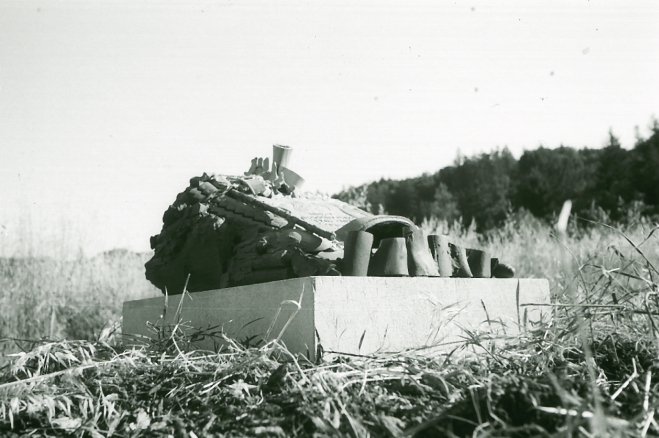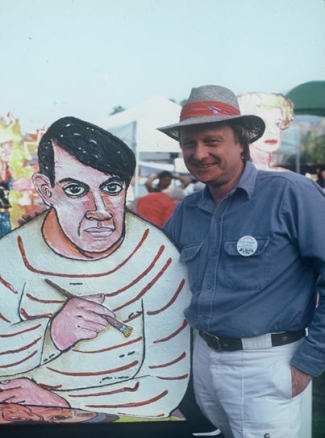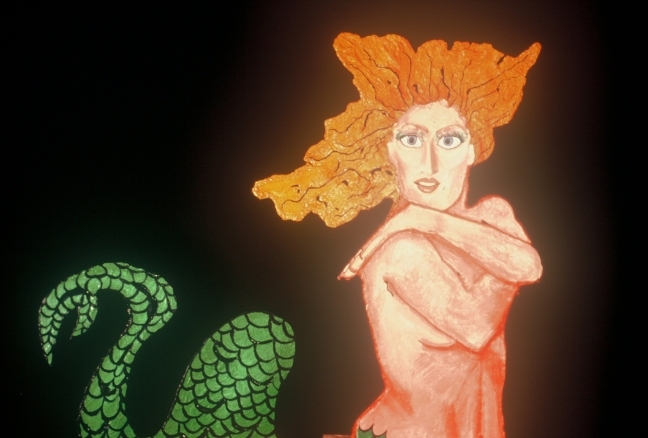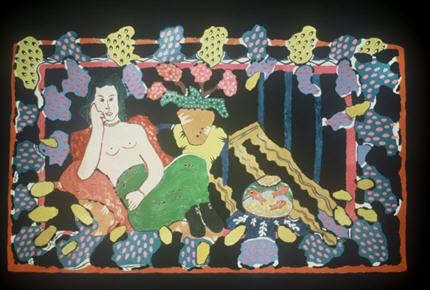|
Press
Zak Zaikine's Transformations
"Zak Zaikine's show, 'Transformations', is a multilayered exploration of materials and states of mind, of waste and redemption ... What he aims for is celebration, protection, and renewal of all life forms; what he speaks of is recycled beauty, classical style ... rebirth."
"To see his work is to experience it through a language of sensibilities, not just optics or formal mental constructs. The works never leave your memory ... existing as vast reservoirs of meaning through accumulated contexts ... they resonate with force and economy the oneness of all things."
"If the pure esthetic of Zaikine's work grips the viewer, it does so because the most ancient of philosophical meditations is constellated."
"My favorite piece has reference not to literary myth but to generic myth, the collective unconscious, the answer to the howling of animals outside in winter, the structure of shelter ... he has a fascinating mind and transmits his ideas into interesting and evocative art."
"Zak Zaikine's present activity in ART all of which is quite new and exciting and very Russian! It suggests the colorful patterned icons to me put into the context of the late 20th century ..." |
|
ARTWEEK Santa Rosa, by Beverly Terwoman Sculptor- photographer- poet Zak Zaikine's show, Transformations, is a multilayered exploration of materials and states of mind, of waste and redemption. It is the first one-person exhibit to be offered by the Sonoma Arts Council's Lincoln Gallery. There are reasons for the unheralded appearance of this show. Zaikine, son of the Russian muralist, Eugene Zaikine, Pratt Institute graduate, sculptor for twenty years, moved only recently from New York to Big Sur and then to the mountains west of Healdsburg. That he has been profoundly affected by this move is evident in his new work's subject matter, materials and treatment. The show begins with direct bronze figurative pieces which recall works Zaikine did when he lived in the east. In addition to these technically fine, traditional works, there are abstract assemblages in which bronze figures as one element only. The early bronze pieces, mounted on Baja onyx, explore state of mind by use of imagery and by changes in the rich green patinas. In Reflections, from the Astral Chimera Series of 1973-1977, a face sees itself in a polished mirror, androgynous males and females contemplate each other, and mythic overtones begin to be heard. The drama of revealed androgyny occurs and resolves in the Shadow of the Mother Series (1968-1978) which shows the archetypal figure of the great creator-destroyer goddess of antiquity - and of the present. In contrast to the internal concerns of the bronze pieces, a group of recent works involves a deteriorating patriarchy which matter-of-factly rapes nature and women. The show is important for the careful documentation of and response to this deadly process in pieces that combine sculpture and photographs. Criticism of twentieth century patriarchal destruction embodied in such sculptures as I'd Rather Shoot Than Fence is strong because each component in the assemblage has a telling cultural and environmental history as well as a formal function. Roots, the sculptural-photographic environment, is a good example. One of the parts is an actual "up-rooter" used by farmers to remove the roots of "bad" fruit trees, so they can be replaced by "good" money-earning plants. This sculpture of metal, concrete, bone, feathers, steel rod and wire is combined with color 35mm photographs of asphalt dumped over the banks of streams, artificial "banks" that arrogantly ignore the processes of nature. The land and its processes, and its accumulation of junk and litter, are evoked in Zaikine's Sanctuary, which at first glance is almost like a cemetery stone, but actually is a small home for survival in the urban wilderness. Lighted by an interior candle, it suggests the possibility of warmth in an otherwise bleak situation. Materials that make up the nest are concrete, wire, rubber tire and part of an old stove, complete with graceful lettering and decorative swirls. About this process of turning our culture's waste into art and about his despair at decisions that make our planet more and more uninhabitable, Zaikine says, "I find far more of interest and value in the elegant iron/steel structures that remain (in the modern ruins of "redevelopment") the corrugation of the walls, the bleeding scars and shadows of antiquity, history and layering of human experience than in any of our malls and standardized districts of today." What he aims for is celebration, protection and renewal of all life forms; what he speaks for is "recycled beauty, classical style, false progress, bones, gold, death, rebirth ..." Even the gallery itself is the result of recycling. Its beautiful fireplace, five half-circle windows, excellent lighting and repair are surprising to find within the damage hull of an old schoolhouse. The gallery is open Tuesday through Sunday, 11am-4pm, and Thursday evening, 7-9pm. 709 Davis Street. |
|
Zak Zaikine/Sculptor
WESTART March 10, 1978 Arranged on sawhorse tables outside sculptor Zak Zaikine's studio - a converted barn in the mountains west of Healdsburg - are neat rows of rusted tools, ancient utensils, shards of machines, hunks of cement, rock, and iron rods gathered from various modern California ruins. The objects are waiting to be joined together in new ways by Zaikine, a direct metal sculptor who has recently taken to combining metal, brick ,bone, chains, antlers, cement, and leather to express his sorrow and concern at the "tear it down and throw it away" mentality that characterizes modern day city planning. He has watched in nearby Santa Rosa as landmark buildings have been razed instead of restored, seen them smashed by iron balls and carted away. His recent sculptures and photographs have been concerned primarily with the beauty and waste of the resulting ruins. When I visited the studio at the end of a long rough dirt road, Zaikine was preparing for the opening of his new show, "Transformations," at the Sonoma Arts Council's Lincoln Gallery in Santa Rosa. It is appropriate for Zaikine's work to be featured as the gallery's first one person show, since the building itself is one of the few to be rescued from "redevelopment." Inside Zaikine's barn I was able to view the show in outline form as well as several pieces still in process. The show will begin with bronze human figures in a series. The first group is titled "Emerging Souls." This theme is then represented in a different form - the emergence of the feminine principle in a man's psyche and its recognition and integration. Then come some bronze pieces on the theme of androgyny, Jung's "spiritual marriage" which leads a person to a rare unity and interior balance, an essential rebirth. From these more introspective, but outwardly more realistic pieces, called the "New Birth" series, Zaikine moves into abstract assemblage statements about external social reality, and the lack of balance he perceives in people's relationships to nature and to each other. These begin with some pieces from his 1975 "Magic Box" series. Outstanding among them is the iconic glass casket containing the figure of a pale dead horse entitled "If you knew how Jell-O was made ..." Some mixed media pieces from the "Landscape" series of 1976-77 will follow Zaikine's intense concern with our culture's wholesale pillage of the animal nations is powerfully expressed in one of these, called "Release the Hold and Unite Yourselves," which features a suspended metal trap and chain in a box environment. Some of the 1977-78 work will be from the most recent series, call "Transformations." These works spring from incidents occurring near Healdsburg, but which will have worldwide ramifications in years to come as the large mammals disappear from the earth. In these Zaikine combines bone, bronze and other found objects to express the anguish and anger he feels when life is stupidly and cruelly destroyed. "I'd Rather Shoot Than Fence," with its sexual overtones, explores the vicious destruction of the deer in the area which are shot intentionally with small caliber bullets and left to wander and die at the water source, ore near Zaikine's studio. "Daddy Won't Be Home Tonight" directs itself to people isolated from the land, trapped in high-rise plastic. The work derives strength from the ease with which its diverse materials combine. Imagine brick, handmade paper, straw, concrete, painted baby doll hands, antlers, combined with an iridescent paint made from fish scales and shells! The highlight of Zaikine's show was, for me the mysterious and evocative "Re-enforce." Heavy sandblasted cow bones are combined with steel rod, heavy rope and twine to produce a literal shout of pain. More comforting is the quiet "Little Hobbit," a small cozy home with light flickering inside, all constructed of metal, rubber tire, pipe and cement. This sculpture is an example of what the artist means when he says, "I find far more of interest and value in the elegant, twisted, iron/steel structures which remain, the corrugation of the walls, the fading colors of old paint, the bleeding scars and shadows of antiquity, history and layering of human experience, than in any of our malls or standardized shopping districts of today." What he aims for is a celebration of life and feeling; what he speaks of is "'recycled beauty, classical style, false progress, bones, gold, death, rebirth ...'" Zaikine, who has exhibited from New York to California in his long career as an artist and writer, is included in many private collections. His show at the Lincoln Arts Center, 709 Davis Street, Santa Rosa, will be on view from March 4-24. An "Open Conversation with the Artist" will take place on Thursday, March 16 from 1-4 p.m. This event should be of interest to artists and historians all over the country because the work addresses the deepest concerns of a society that must transform its value system or face extinction - OUR society. |
|
Kleinert shows artist who never slows down
Mikhail Horowitz SHADY - Calling Zak Zaikine a prolific artist is like calling Moby Dick a large marine animal, or Moses an impressive religious teacher. Somehow, the words fall short of conveying the awesome reality. "Like a race horse that loves to run, I love to work, and I wish I could work more," says Zaikine, a hardy, blond bear of a man who's tapped into a seemingly inexhaustible wellspring of creative energy. "It appears that I work an awful lot, but I also do other things, like cut wood and take care of my child, so my wife can do her work." Where on earth he finds time to cook borscht, cut and stack a couple of cords for his humongous wood-burning stove, pal around with his wife Adrianne and daughter Anastasia, and still produce an endlessly variegated and compelling oeuvre of sculpture, paintings, pastels and prints, only the ghost of Picasso knows. "Well, we don't have a TV," he says with a laugh, when pressed. "We haven't had that intrusion in our lives on a daily basis for 15 years, and that alone could answer the question of why I work so much!" A show of Zaikine's latest polychrome steel sculptures, depicting brightly colored mermaids and moonmaidens in thin, parti-colored sheets and plates of metal, opens tonight at the Kleinert Arts Center in Woodstock, along with paintings by Lisa Phillips. He's also currently exhibiting etchings and selected smaller bronzes at Woodstock's Ann Leonard Gallery, and other works in bronze at the Clark Whitney Gallery in Lennox, Mass. Additionally, his early drawings will be on view Sept 18-Oct. 27 at The Work of Art Gallery in Saugerties, and he'll be doing a one-person show at the Woodstock Artists Association Oct. 6-31. If Zaikine's productivity seems to rival Mother Nature's, perhaps that's no coincidence. His earliest work was deeply connected to a love of the land, and was ecologically motivated. "I did ritual performance pieces and earthworks," he says. "They were the synthesis of a lot of things that were very dear and holy to me." Among these ritualistic enactments was a piece involving the use of maize and corn, installed at the WAA when the artist, emigrating from California, arrived in the area five years ago. "I created a maze with maize," Zaikine explains. "I took the W from Woodstock and doubled it four times, and the corn grew in this pattern ...It was a growth piece; it became a mandala." Everything about the process was magical, the artist recalls. Averse to using hybrid seeds, he lucked upon a bunch of kernel derived from a 2,000 year-old strain of Hopi sacred corn, bestowed upon him by a local musician via a local writer. "That just blew me away," he says, adding that the Indian kernels grew bright red and made a beautiful contrast when interspersed with the common corn, as well as lending the project a religious resonance. Though he's "dealing with a different type of energy" in his recent works, Zaikine retains a planetary awareness in relation to his materials. He's acutely sensitive to the properties of various metals, and to the way in which not only the metal, but the consciousness employing it, is transformed in the process of making art. "One-third of my sculpture is made from recycled metal," he says. "We've reached a point where we have to seriously start thinking about taking any more metal out of the earth ...We could survive very comfortably on what we have if we start cleaning up." As one might surmise from his nonstop productivity and philosophical bent, Zaikine doesn't work on a monumental scale. His sculptural pieces range from toy-sized to, well, Zak Zaikine-sized. "A good friend- Dominic Di Mare, a West Coast artist - used to say that he never made anything he couldn't carry," Zaikine says. "I agreed; we felt, why make anything larger than ourselves?" There's also a recycling sensibility at play in the content of his recent metal pieces. Delving into the motherlode of contemporary culture, Zaikine has mined familiar images and icons - Popeye, Archie - and resuscitated them in a new light, with fresh and surprising results. "I make accessible images, using the imagery that I, as a white male American youth, grew up with in the '50s and '60s," he says. "Every piece has an important tie-in with my life and how I view the world, and with how my psyche is working." The pieces combine the vibrant colors and rapid lightness of comic strips or children's drawings with the durable, tensile strength of the molded steel. By attempting to solidify a certain kind of innocence or exuberance and making it last forever, they pose a charming paradox. Though he's had a great response to these cartoony, cookie=cut steel sculptures, Zaikine will most assuredly be moving on in his artistic odyssey following the Kleinert exhibition. "For me, repetition is the most excruciating pain I could have," he winces. "I know a piece is complete when I actually get physically sick about wanting to do any more to it." Enthusiastic and engaging in conversation as he is in his artwork, Zaikine is boyishly modest about his achievements, happy to receive praise and yet slightly uncomfortable with it. Nevertheless, he's effusive in his praise of other artists, and doesn't forget what he's learned from them. "Nick Buhalis is a very important person; he was instrumental in having me see things deeper and more clearly," says Zaikine of the Woodstock artist. "He's truly a teacher - he just gives." He adds that it's always gratifying to sell work to one's peers, and that in many cases, it's really other artists who keep an artist alive. "You know, the popular version of Woodstock is that it's a bunch of artists paining in a garret, but the reality is that we have to survive," says Zaikine, sorting through a creased rainbow of tubes - Cadmium Yellow, Burnt Sienna and Iridescent Gold - in his rustic studio. "People might view a work priced at $500 and say, 'Omigod, it's just a few dabs and brushstrokes,' but it may have taken the artist a lifetime to get that particular effect." Artistically, at least, Zaikine has crammed nine lifetimes into one. "At the age of four, I knew I came back to be an artist," he laughs. "It's like having money in the bank from someplace else."
Zak Zaikine's sculpture and Lisa Phillips' paintings are on view at the Kleinert Arts Center, 34 Tinker St., Woodstock, through Aug. 26. Opening reception is 5:00-8:00p.m. tonight. Gallery hours are 11:00-6:00 p.m., Wednesday through Monday. Zaikine's small bronzes are on view at the Ann Leonard Gallery, 63 Tinker St., Woodstock, 11:00-6:00 pm daily.
|
|
From what place do you come?
Marijo Dougherty It sometimes does happen, when seeing an artist's work for the first time, that one is tempted to inquire of the artist, in the spirit of the Odyssey, "From What Place Do You Come?" It is less for information that the question is asked, than for acknowledging that there is a memory-laden chord deep within ourselves that the artist has somehow struck. When I first encountered the work of Victor (Zak) Zaikine in 1983 at the Schenectady Museum (Artists of the Mohawk Hudson Regional), I was intrigued that the artist would use this mode of self-expression, utilizing a sense of popular culture as well as scene. Filtered through the artist's own personal identity, the work presented a strong element of surrealism intermingled somewhat with the reality of Pop. I remember a distinct desire at the time to learn more about the artist and his work but as often happens, events interrupted good intentions. When I next encountered Zak's work, it was at the Jamie Szoke Gallery in Soho (NYC) in 1984. Here I learned that the artist was born in 1941, of Russian parents (his father, Eugene Zaikine, was a Russian muralist of some note) that he studied at Pratt Institute (Brooklyn) and that he was an accomplished draftsman (under the tutelage of Nicholas Buhalis), as well as a metalworker, which included expertise in bronze casting. All of which gave him extraordinary technical skills with which to do his storytelling. His career during this period was continuing on an up-hill course of exhibitions and awards. He had returned to his Woodstock studio some years earlier after living for a time in California, where he participated in that major Earthworks of the late 1970s. (Could these be the Earthern Mounds in which abide Zak's Fairy-Folk?) The work shown in this 1984 show was so outside the art world dogma of the period and was so wholly, exuberantly American, that it demanded and received considerable attention. I still had not personally met Zak and was therefore delighted to learn in the summer of 1985 that he was among those selected to exhibit in the University Art Gallery at the University at Albany in the 1985 Artists of the Mohawk Region Juried Exhibition. It was certainly a pleasurable first encounter, experiencing the artist's quick wit and expansive imagination. Indeed, he was as alive as is his work. He seems to have always had an inexhaustible wellspring of creative energy and drive. Drawing on his deep repertoire of narrative elements he utilizes them in an extremely expressive link between text and imagery, awakening in us our hidden impulses and childhood fantasies. He is able to take the viewer on a journey imaginable only in art (perhaps an intermingling of (Hieronymus Bosch and Beatrix Potter). There exists the potential in this type of work to be overly autobiographical and introspective. But Zak's work is rescued from an excessive narrative approach by his inventiveness and playful relationship of form. He does not allow too much to be told and yet there is much for the telling. His Father's death was a great blow to the seven-year-old artist-to-be. Zak transferred his father's lost physical presence and authority to the fantastically painted mermaids and other creatures left behind in his father's treasure trove of paintings. (A series of works in bronze from Zak's early career dealt exclusively with the theme of death.) Zak credits, in large measure, his young daughters Lynda and Anastasia as being the catalysts which moved him towards the themes present in his current work. Zak's exposure to feminine mythology and imagery at an early age is evident in his work as well as in his personal life. He is a committed humanist, deeply involved in the women's movement and other causes for social justice, adamantly opposed to war and its atrocities. He has an environmentalist's consciousness, a macrobiotic personal lifestyle and a belief in the sacredness of life on this planet. Zak's early exposure to Icon painting, with its highly emotional and solemn treatment of subject matter that gives the feeling of exaltation and impetuosity, coupled with the artist's technical mastery and inventiveness, allows him to join the immediate present with the art historical past and places his work among the modern masters he so admires. |




